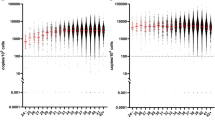Abstract
Objectives
Primary Immunodeficiency diseases (PID) are a heterogeneous group of inherited disorders of immune system. Immunophenotypic evaluation of PIDs using flowcytometry provides important clues for diagnosis of these disorders, though confirmation requires identification of underlying molecular defects. Prenatal diagnosis (PND) forms an important component of management in families affected with severe PID. However, molecular diagnostic facilities for each of these diseases are not available and may not be possible to perform in all cases. In such scenario we opted for phenotypic prenatal diagnosis by cordocentesis for families with index case having immunophenotypically well characterized PID.
Methods
Normal reference ranges of lymphocyte subsets, CD 18/CD11 integrins on leukocytes, MHC class II expression and oxidative burst activity of fetal neutrophils at 18 weeks of gestation were previously established on 30 cord blood samples. PND was performed in 13 families with PIDs. Maternal contamination was ruled out by VNTR analysis.
Results
Out of 13 fetuses, nine were found to be unaffected (three cases with leukocyte adhesion deficiency (LAD-I), four cases with severe combined immunodeficiency diseases (SCID), one with X-linked agammaglobulinemia (XLA), and one with chronic granulomatous disease (CGD)] and three were found to be affected (one with T-B+NK-SCID, one with MHC class II deficiency and one with LAD-I). Diagnosis was confirmed by testing the cord blood samples after delivery and further follow-up of the children. In one family diagnosis could not be offered due to maternal contamination. No procedure related complications were observed.
Conclusion
Flowcytometry offers rapid and sensitive method for prenatal diagnosis and genetic counseling for selected phenotypically well characterized PID in cases where molecular diagnostic facilities are not available.



Similar content being viewed by others
References
Al-Herz W, Bousfiha A, Casanova JL, et al. Primary immunodeficiency diseases: an update on the classification from the international union of immunological societies expert committee for primary immunodeficiency. Front Immunol. 2011;2:1–26.
Sponzilli I, Notarangelo LD. Severe combined immunodeficiency (SCID): from molecular basis to clinical management. Acta Biomed. 2011;82:5–13.
Gupta S, Madkaikar M, Singh S, et al. Primary immunodeficiencies in India: a perspective. Ann N Y Acad Sci. 2012;1250:73–9.
Madkaikar MR, Gupta M, Rao M, et al. Prenatal diagnosis of LAD-I on cord blood by flowcytometry. Indian J Pediatr. 2012;79(12):1605–9. doi:10.1007/s12098-012-0737-5.
Ayatollahi M, Tabeiet Z, Ramzi M, et al. A fast and easy nitroblue tetrazolium method for carrier screening and prenatal detection of chronic granulomatous disease. Arch Iran Med. 2006;9:335–8.
O’Gorman MR, Corrochano V. Rapid whole-blood flow cytometry assay for diagnosis of chronic granulomatous disease. Clin Diagn Lab Immunol. 1995;2:227–32.
Futatani T, Miyawaki T, Tsukada S, et al. Deficient expression of Bruton’s tyrosine kinase in monocytes from X-linked agammaglobulinemia as evaluated by a flow cytometric analysis and its clinical application to carrier detection. Blood. 1998;91:595–602.
Wood P, Stanworth S, Burton J, et al. UK Primary Immunodeficiency Network. Recognition, clinical diagnosis and management of patients with primary antibody deficiencies: a systematic review. Clin Exp Immunol. 2007;149:410–23.
Oliveira JB, Notarangelo LD, Fleisher TA. Applications of flow cytometry for the study of primary immune deficiencies. Curr Opin Allergy Clin Immunol. 2008;8:499–509.
D’Souza E, Sawant PM, Nadkarni AH, Gorakshakar A, Mohanty D, Ghosh K, et al. Evaluation of the use of monoclonal antibodies and nested PCR for noninvasive prenatal diagnosis of hemoglobinopathies in India. Am J Clin Pathol. 2008;130(2):202–9.
Chiu RW, Lo YM. Clinical applications of maternal plasma fetal DNA analysis: translating the fruits of 15 years of research. Clin Chem Lab Med. 2013;51(1):197–204.
Chou J, Ohsumi TK, Geha RS. Use of whole exome and genome sequencing in the identification of genetic causes of primary immunodeficiencies. Curr Opin Allergy Clin Immunol. 2012;12(6):623–8.
Avila EM, Uzel G, Hsu A, Milner JD, Turner ML, Pittaluga S, et al. Highly variable clinical phenotypes of hypomorphic RAG1 mutations. Pediatrics. 2010;126(5):e1248–52.
Sigmon JR, Kasasbeh E, Krishnaswamy G. X-linked agammaglobulinemia diagnosed late in life: case report and review of the literature. Clin Mol Allergy. 2008;6:5. doi:10.1186/1476-7961-6-5.
Tongsong T, Wanapirak C, Kunavikatikul C, et al. Cordocentesis at 16–24 weeks of gestation: experience of 1,320 cases. Prenat Diagn. 2000;20:224–8.
Liao C, Wei J, Li Q, et al. Efficacy and safety of cordocentesis for prenatal diagnosis. Int J Gynaecol Obstet. 2006;93(1):13–7.
Srivorakun H, Fucharoen G, Sae-Ung N, et al. Analysis of fetal blood using capillary electrophoresis system: a simple method for prenatal diagnosis of severe thalassemia diseases. Eur J Haematol. 2009;83:57–65.
Colah RB, Gorakshakar AC, Nadkarni AH. Invasive & non-invasive approaches for prenatal diagnosis of haemoglobinopathies: experiences from India. Indian J Med Res. 2011;134:552–60.
Shetty S, Ghosh K. Robustness of factor assays following cordocentesis in the prenatal diagnosis of haemophilia and other bleeding disorders. Haemophilia. 2007;13:172–7.
Durandy A, Oury C, Griscelli C, et al. Prenatal testing for inherited immune deficiencies by fetal blood sampling. Prenat Diagn. 1982;2:109–13.
Linch DC, Beverley PC, Levinsky RJ, et al. Phenotypic analysis of fetal blood leucocytes: potential for prenatal diagnosis of immunodeficiency disorders. Prenat Diagn. 1982;2:211–8.
Weening RS, Bredius RG, Wolf H, et al. Prenatal diagnostic procedure for leukocyte adhesion deficiency. Prenat Diagn. 1991;11:193–7.
Puck JM, Routes J, Filipovich AH, Sullivan K. Expert commentary: practical issues in newborn screening for severe combined immune deficiency (SCID). J Clin Immunol. 2012;32(1):36–8.
Contributors
MM and KG conceptualized the paper. AM, MG and AD helped in laboratory assessment. AM and MG participated in the analysis and interpretation of the data. MM and AM prepared the manuscript. Finally the manuscript has been approved by all.
Author information
Authors and Affiliations
Corresponding author
Rights and permissions
About this article
Cite this article
Mishra, A., Gupta, M., Dalvi, A. et al. Rapid Flow Cytometric Prenatal Diagnosis of Primary Immunodeficiency (PID) Disorders. J Clin Immunol 34, 316–322 (2014). https://doi.org/10.1007/s10875-014-9993-7
Received:
Accepted:
Published:
Issue Date:
DOI: https://doi.org/10.1007/s10875-014-9993-7




